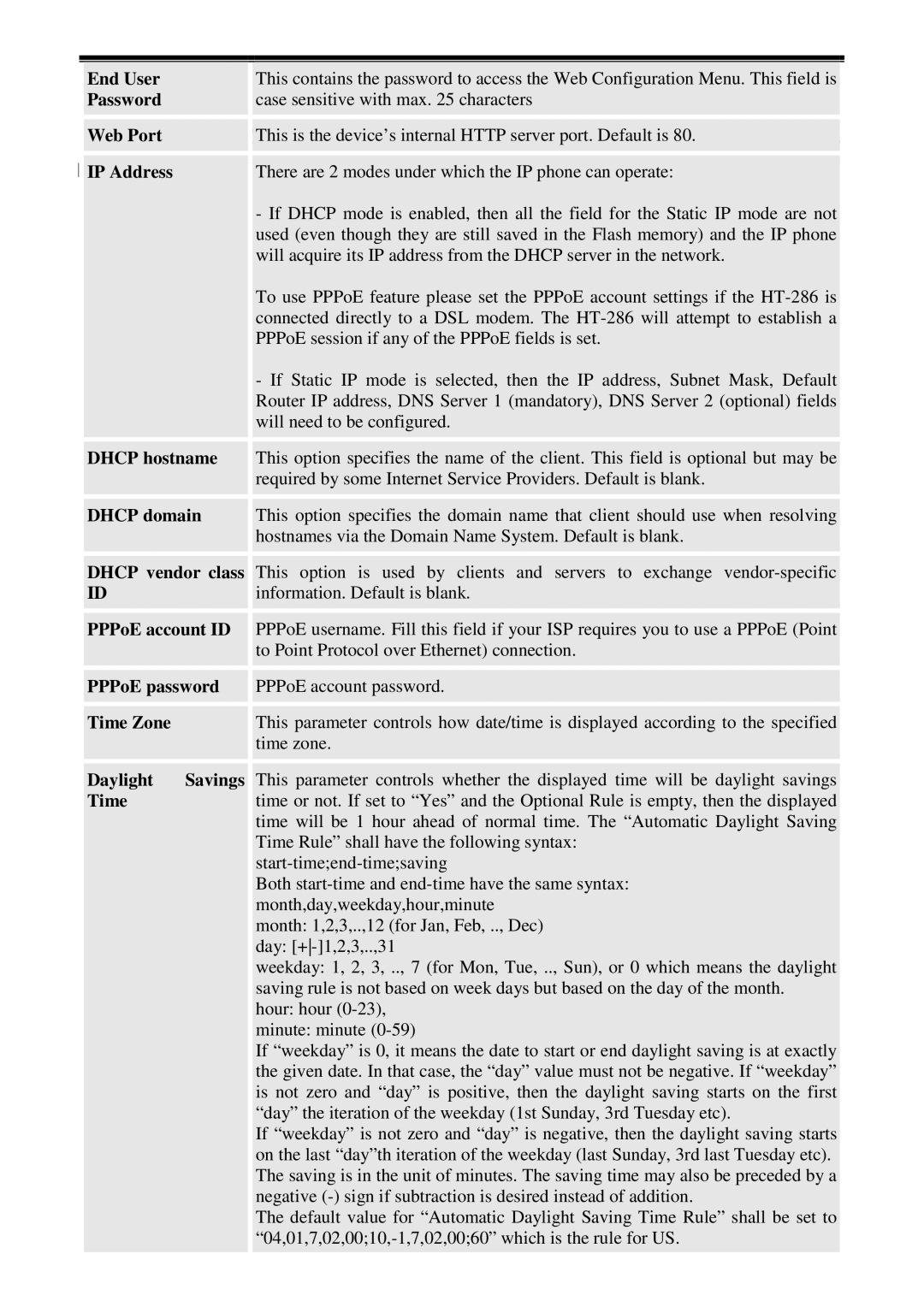
|
|
|
|
|
| End User |
| This contains the password to access the Web Configuration Menu. This field is |
|
| Password |
| case sensitive with max. 25 characters |
|
|
|
|
|
|
| HandyTone |
|
| . | ||
| User Manual | Grandstream Networks, Inc | ||||
| Web Port |
|
| This is the device’s internal HTTP server port. Default is 80. |
| |
|
|
|
|
|
|
|
|
|
|
|
| ||
| IP Address |
|
| There are 2 modes under which the IP phone can operate: |
| |
|
|
|
| - If DHCP mode is enabled, then all the field for the Static IP mode are not |
| |
|
|
|
| used (even though they are still saved in the Flash memory) and the IP phone |
| |
|
|
|
| will acquire its IP address from the DHCP server in the network. |
| |
|
|
|
| To use PPPoE feature please set the PPPoE account settings if the |
| |
|
|
|
| connected directly to a DSL modem. The |
| |
|
|
|
| PPPoE session if any of the PPPoE fields is set. |
| |
|
|
|
| - If Static IP mode is selected, then the IP address, Subnet Mask, Default |
| |
|
|
|
| Router IP address, DNS Server 1 (mandatory), DNS Server 2 (optional) fields |
| |
|
|
|
| will need to be configured. |
|
|
|
|
|
|
|
|
|
|
|
|
| |||
| DHCP hostname |
| This option specifies the name of the client. This field is optional but may be |
| ||
|
|
|
| required by some Internet Service Providers. Default is blank. |
| |
|
|
|
|
|
|
|
|
|
|
| |||
| DHCP domain |
| This option specifies the domain name that client should use when resolving |
| ||
|
|
|
| hostnames via the Domain Name System. Default is blank. |
| |
|
|
|
|
|
|
|
|
|
|
| |||
| DHCP vendor class |
| This option is used by clients and servers to exchange |
| ||
| ID |
|
| information. Default is blank. |
|
|
|
|
|
|
|
|
|
|
|
|
| |||
| PPPoE account ID |
| PPPoE username. Fill this field if your ISP requires you to use a PPPoE (Point |
| ||
|
|
|
| to Point Protocol over Ethernet) connection. |
| |
|
|
|
|
|
|
|
|
|
|
|
|
| |
| PPPoE password |
| PPPoE account password. |
|
| |
|
|
|
|
|
|
|
|
|
|
|
| ||
| Time Zone |
|
| This parameter controls how date/time is displayed according to the specified |
| |
|
|
|
| time zone. |
|
|
|
|
|
|
|
|
|
|
|
|
|
| ||
| Daylight | Savings |
| This parameter controls whether the displayed time will be daylight savings |
| |
| Time |
|
| time or not. If set to “Yes” and the Optional Rule is empty, then the displayed |
| |
|
|
|
| time will be 1 hour ahead of normal time. The “Automatic Daylight Saving |
| |
|
|
|
| Time Rule” shall have the following syntax: |
| |
|
|
|
|
|
| |
|
|
|
| Both |
| |
|
|
|
| month,day,weekday,hour,minute |
|
|
|
|
|
| month: 1,2,3,..,12 (for Jan, Feb, .., Dec) |
|
|
|
|
|
| day: |
|
|
|
|
|
| weekday: 1, 2, 3, .., 7 (for Mon, Tue, .., Sun), or 0 which means the daylight |
| |
|
|
|
| saving rule is not based on week days but based on the day of the month. |
| |
|
|
|
| hour: hour |
|
|
|
|
|
| minute: minute |
|
|
|
|
|
| If “weekday” is 0, it means the date to start or end daylight saving is at exactly |
| |
|
|
|
| the given date. In that case, the “day” value must not be negative. If “weekday” |
| |
|
|
|
| is not zero and “day” is positive, then the daylight saving starts on the first |
| |
|
|
|
| “day” the iteration of the weekday (1st Sunday, 3rd Tuesday etc). |
| |
|
|
|
| If “weekday” is not zero and “day” is negative, then the daylight saving starts |
| |
|
|
|
| on the last “day”th iteration of the weekday (last Sunday, 3rd last Tuesday etc). |
| |
|
|
|
| The saving is in the unit of 21minutes. The saving time may also be preceded by a |
| |
|
|
|
| negative |
| |
|
|
|
| The default value for “Automatic Daylight Saving Time Rule” shall be set to |
| |
|
|
|
|
| ||
|
|
|
| l |
|
|
